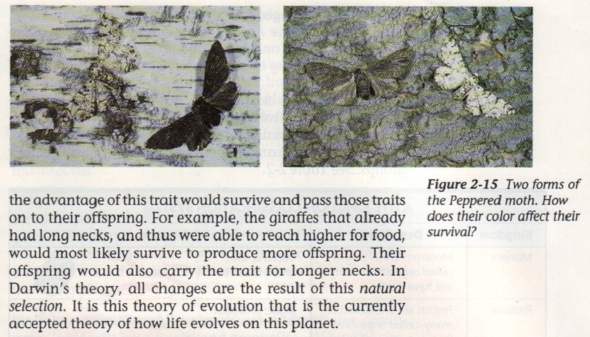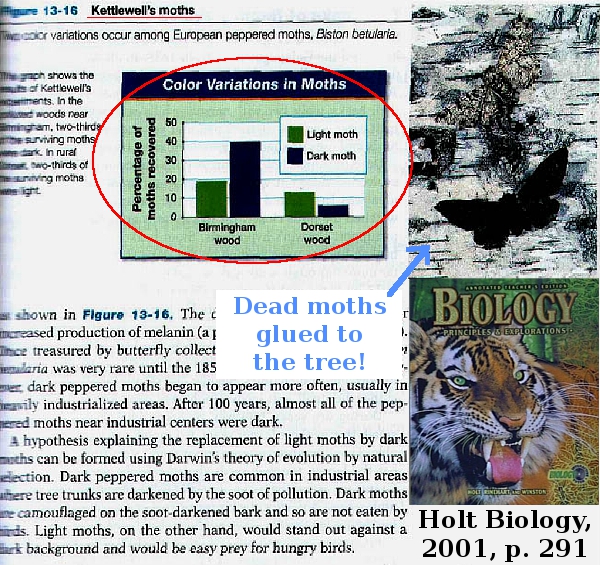"Rapid changes in species have been observed.These [Peppered Moths] support the theory of evolution. "
-"Evidence for Evolution - Rapid Changes: Peppered Moths," BBC, retrieved Apr 6, 2013, [http://www.bbc.co.uk/schools/gcsebitesize/science/aqa_pre_2011/evolution/evolutionrev4.shtml]
Notice first how evolution is not properly defined in their conclusion because they are giving an example of a MICRO-evolution change, and then expecting the reader to make the giant leap of faith to say that is evidence that supports MACRO-evolution, which is not true at all. The peppered moth study still remains one of the most commonly used evidences for evolution, despite that it provides no help for the general religious evolutionary hypothesis.

 |
It should be noted here that the moths in the image above are dead moths glued to a tree. The people involved in this study couldn't find living moths resting on the trees for their photographs.
In the 1950s, a man named Henry Bernard Kettlewell ran experiments in England to examine the effects of the nearby industrial factories on the environment of the surrounding forest, and he ended up specifically studying a type of moth known as the 'peppered' moth. Typically white with speckles, the peppered moth is well-camoflauged on the white-barked trees of the forest, but the new factories were turning the trees black from soot. Kettewell decided to release large amounts of peppered moths into the forest to see what would happen, and his reports stated that the birds would eat primarily the white moths, since they were showing up on the newly blackened trees. |
In 40 years of research, a total of two moths were found resting on the trees. The peppered moth does not normally rest on tree trunks, but higher up in dark places where they cannot be seen by predators.
(See Michael E. N. Majerus, Melanism - Evolution in Action, Oxford University Press, 1998, p. 338, ISBN: 9780198549826)
With that information, take a look at the following textbook's chart on the peppered moths:

When Kettlewell released large groups of moths into the forest on a number of occasions, he expected to study the survival patterns based on their camoflauged resting state, but he created a conditioned feeding response by the surrounding birds. That's like wanting to study the grazing habits of horses by dumping food into feeding troughs for them on a regular basis. It is impossible to find a natural patternw when you create an artificial one.
The survival patterns of the moths were assumed to be based off of the camoflauge of man's eyes, instead of a bird's eyes. Birds see things differently from man, so what may be camoflauged to us, will be easily seen by a bird.
The selection process evolutionists are referring to could have come from the catapillar stage before they were fully-grown moths, but Kettlewell only studied the fully developed moths.
Kettlewell ignored the fact that peppered moths hide underneath high tree branches while they rest during the day to avoid birds. The main predators of peppered moths are night-flying bats, and they do not use normal sight to detect moths, they use sound with echo-location!
Kettlewell's "research" is not fit to be called an experiment because it is based on a large number of false assumptions, but despite this, the peppered moth is still used as evidence for evolution in textbooks, museums, and zoos across the world.

"School children need to learn that the peppered moth story...does not show that large scale evolution can occur . They should also understand that the original experiments behind the peppered moth story have widely acknowledged flaws, and some of these issues have been addressed in more recent experiments."
-"The Peppered Moth," Truth in Science, retrieved Apr 6, 2013, [http://www.truthinscience.org.uk/tis2/index.php/component/content/article/127.html]
Evolutionists cannot get rid of these pathetic examples as their evidence for evolution because they have nothing else to support the religious idea that we came from monkeys, monkeys came from fish, and fish came from rocks 3 billion years ago.













![There is No Saving Grace Without Repentance [creationliberty.com]](../images/store13a.jpg)
![Wolves in Costume: Kent Hovind [creationliberty.com]](../images/store11a.jpg)
![Corruptions of Christianity: Seventh-day Adventism [creationliberty.com]](../images/store09a.png)
![501c3: The Devil's Church [creationliberty.com]](../images/store07a.jpg)
![Feminism: Castrating America [creationliberty.com]](../images/store04a.jpg)







![Why Millions of Believers on Jesus Are Going to Hell [creationliberty.com]](images/store05a.jpg)
![Corruptions of Christianity: Catholicism [creationliberty.com]](http://www.creationliberty.com/images/store14a.jpg)
![False Prophet Profiles: Kim Clement [creationliberty.com]](http://www.creationliberty.com/images/store12a.jpg)
![Christmas: Rejecting Jesus [creationliberty.com]](http://www.creationliberty.com/images/store10a.jpg)
![Christian Music: For The Love of Money [creationliberty.com]](images/store08a.png)
![Psychology: Hoodwinked by the Devil [creationliberty.com]](images/store06a.jpg)
